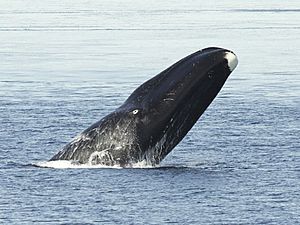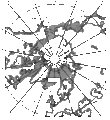Bowhead whale facts for kids
Quick facts for kids Bowhead Whale |
|
|---|---|
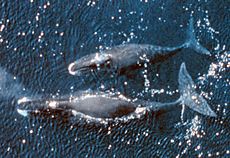 |
|
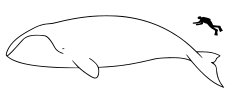 |
|
| Size comparison against an average human | |
| Conservation status | |
| Scientific classification | |
| Kingdom: | |
| Phylum: | |
| Class: | |
| Order: | |
| Suborder: | |
| Family: | |
| Genus: |
Balaena
|
| Species: |
B. mysticetus
|
| Binomial name | |
| Balaena mysticetus |
|
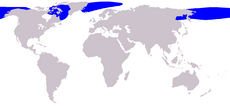 |
|
| Bowhead whale range | |
The bowhead whale (Balaena mysticetus) is a large baleen whale that lives in the Arctic. It's a type of right whale with a huge, bow-shaped head. This head can be up to 40% of its body length! Its mouth is very big, about 10 feet (3 m) wide and 20 feet (6 m) deep.
Bowheads have the largest mouth of any animal. It makes up almost one-third of their body. They also have the longest baleen plates, which can be up to 4 meters (13 feet) long. These whales might be the longest-living mammals, able to live for more than 200 years. They have two blowholes and a thick layer of blubber, which is like a very thick layer of fat. This blubber can be 20 inches (50 cm) thick in some places.
Contents
Behavior
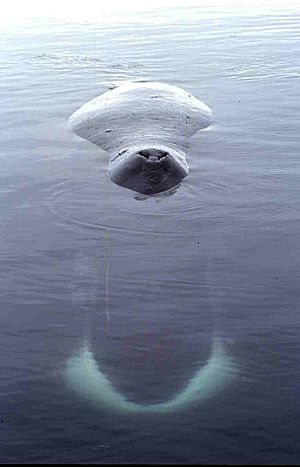
Swimming
Bowhead whales usually travel alone or in small groups of up to six. They can hold their breath and stay underwater for up to an hour. However, they usually only stay submerged for 9 to 18 minutes. These whales are not known to dive very deep, but they can reach depths of up to 500 feet.
They are slow swimmers, typically moving at about 2 to 5 kilometers per hour (1 to 3 mph). If they need to escape danger, they can swim faster, up to 10 km/h (6 mph). When they are eating, their speed slows down to about 1.1 to 2.5 meters per second.
Feeding
The bowhead whale's head is huge, making it perfect for feeding. They are filter feeders, which means they swim with their mouths open to catch tiny food. The whale has hundreds of overlapping plates called baleen hanging from its upper jaw. These plates are made of keratin, similar to your fingernails.
As the whale swims, water filters through the fine hairs on the baleen plates. This traps small prey near the whale's tongue, which it then swallows. Their diet mainly consists of zooplankton, including tiny creatures like copepods and amphipods. A bowhead whale can eat about 2 tons of food every day! When they are looking for food, they can be alone or in groups of two to ten or more.
Vocalization
Bowhead whales are very noisy. They use low-pitched sounds (below 1000 Hz) to talk to each other. They use these sounds when traveling, eating, and socializing. They make strong calls for communication and finding their way, especially during migration. During breeding season, bowheads sing long, complex songs to attract mates.
Reproduction
Bowhead whales mate in pairs or in lively groups of several males and one or two females. The breeding season is from March to August. Most babies are thought to be conceived in March when the whales sing the most. Whales can start having babies when they are 10 to 15 years old.
A female whale carries her baby for 13 to 14 months. She usually has one calf every three to four years. The baby whale drinks milk for about a year. To stay warm in the cold water, calves are born with a thick layer of blubber. Within 30 minutes of birth, bowhead calves can swim on their own. A newborn calf is typically 4 to 4.5 meters (13 to 15 feet) long and weighs about 1000 kg (2,200 pounds). They grow to about 8.2 meters (27 feet) within their first year.
Health
Lifespan
Bowhead whales are famous for being among the longest-living mammals. They can live for over 200 years! In 2007, a 15-meter (49-foot) whale caught off the coast of Alaska had an old harpoon head stuck in it. This harpoon was made between 1879 and 1885. Experts believe the whale was hit around 1890.
This discovery led scientists to check the ages of other bowhead whales. One whale was estimated to be 211 years old! Others were found to be between 135 and 172 years old. This showed that bowhead whales live much longer than people first thought.
Genetic Causes
Scientists used to think that the more cells an animal has, the higher its chances of getting diseases like cancer. But bowhead whales have thousands of times more cells than many other mammals, yet they are very resistant to cancer and aging.
In 2015, scientists studied the whale's genome (all its genetic information). They found two special genes that might help the whale live so long. These genes, called ERCC1 and PCNA, are important for repairing damaged DNA. This ability to fix DNA damage better helps bowhead whales resist cancer and live longer lives. Their genes might also explain why they have a lower metabolism compared to other mammals.
Ecology
Range and Habitat
The bowhead whale is the only baleen whale that spends its entire life in the Arctic and nearby cold waters. The whales living near Alaska spend winter in the southwestern Bering Sea. In spring, they travel north, following openings in the ice, into the Chukchi and Beaufort seas. Where they live can change depending on the climate and how the ice forms and melts.
Long ago, bowhead whales might have lived in a wider, more southern area. Fossils have been found in places like Italy and North Carolina.
Population
There are generally five main groups, or "stocks," of Bowhead Whales. These include:
- The Western Arctic stock (Bering, Chukchi, and Beaufort Seas)
- The Hudson Bay and Foxe Basin stock
- The Baffin Bay and Davis Strait stock
- The Sea of Okhotsk stock
- The Svalbard-Barents Sea Spitsbergen stock
Recent studies suggest that the Hudson Bay and Foxe Basin stock and the Baffin Bay and Davis Strait stock might actually be one large group.
Western Arctic
The Western Arctic Bowhead population has grown a lot since commercial whaling stopped. A study in 2011 estimated there were about 16,892 whales. This is more than three times the number in 1978! This group is growing by about 3.7% each year. This means the Western Arctic Bowhead stock might be back to its original numbers before people started hunting them for business.
Native Alaskan people still hunt a small number of bowhead whales for food and their way of life. The Alaska Eskimo Whaling Commission sets limits on how many whales each village can hunt. This annual hunt is very small, only about 0.1-0.5% of the population.
Baffin Bay and Davis Strait
In 2008, Canada's Department of Fisheries and Oceans said there were more whales in the eastern Arctic than previously thought. They estimated about 14,400 animals. These numbers are similar to how many whales there were before whaling, suggesting this population has fully recovered. However, if climate change causes sea ice to shrink, more ship traffic could threaten these whales.
We don't know as much about other populations. In 2006, there were about 1,200 whales off West Greenland. The Svalbard population might only have a few tens of whales, but their numbers have been increasing recently.
Sea of Okhotsk
Not much is known about the endangered Sea of Okhotsk population. These whales are often seen near the Shantar Islands, very close to the shore. Some companies offer whale watching tours there. Russian scientists believe this whole population is likely no more than 400 animals.
Scientists didn't study this group much before 2009. That's when researchers studying belugas noticed many bowheads in the area. Because of this, bowheads in the Sea of Okhotsk were once called "forgotten whales." The WWF helped create a nature sanctuary in this region.
Sometimes, whales from this population might travel to Asian countries like Japan or the Korean Peninsula. The first time a bowhead whale was seen alive in Japanese waters was in 2015. Genetic studies suggest that the Okhotsk population is related to the whales in the Bering-Chukchi-Beaufort Seas.
Svalbard-Barents Sea
The Svalbard/Spitsbergen population is the most endangered, but it was once the largest. These whales usually live in the Fram Strait, Barents Sea, and areas near Severnaya Zemlya. Historically, they were seen all over the European and Russian Arctic coasts, even reaching Iceland and Scandinavian coasts.
Today, very few sightings happen in other areas, but they are becoming more regular. Whales have even started coming close to towns like Longyearbyen. The waters around the Franz Josef Land marine mammal sanctuary might be the most important home for this population.
Scientists are not sure if this group is just what's left of the old Svalbard population, or if new whales have moved in from other groups. In 2015, a large group of whales (80–100 individuals) was found between Spitsbergen and Greenland. This suggests that more whales survived the whaling periods than previously thought.
Possible Moulting Area on Baffin Island
In 2012, a tour group found a large group of bowhead whales in shallow bays south of Qikiqtarjuaq. The whales seemed to be involved in courtship. Floating skin and rubbing behavior on the sea bottom suggested they might have been moulting (shedding their skin). This behavior had rarely been seen in this species before. This area is an important home for these whales, which belong to the Davis Strait stock.
Isabella Bay in Niginganiq National Wildlife Area is the first wildlife sanctuary made especially for bowhead whales.
Predation
The main predators of bowhead whales are humans. Killer whales are also known to hunt them. When threatened by killer whales, bowheads try to find safety in the ice or shallow waters.
Whaling
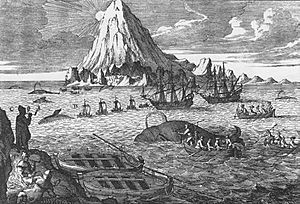
The bowhead whale was hunted for its blubber, meat, oil, bones, and baleen. Like the right whale, it swims slowly and floats after it dies, which made it easy for whalers to catch. Before commercial whaling began, there were an estimated 50,000 bowhead whales.
Commercial bowhead whaling started in the 1500s. Whalers from the Basque region hunted them as they migrated south. In 1611, the first whaling trip sailed to Spitsbergen. By the mid-1600s, the whale populations there were almost gone. This forced whalers to go further, into the "West Ice" off Greenland's east coast. By the 1700s, they reached the Davis Strait, and by the early 1800s, Baffin Bay.
In the North Pacific, bowheads were first caught in 1845. By 1849, 50 ships were hunting bowheads in different areas. By 1852, 220 ships were in the Bering Strait region, killing over 2,600 whales. Between 1848 and 1914, an estimated 18,600 bowheads were killed in the Bering Strait region. Another 18,000 were killed in the Sea of Okhotsk between 1847 and 1867.
Commercial whaling, which caused the whale population to drop, has now ended. Today, bowhead whales are only hunted by native peoples of North America for their own needs, not for business.
Images for kids
-
Stamp showing drawing of mother and calf from Faroe Islands
-
Whale spyhops in Ulbansky Bay, northwestern Okhotsk Sea
-
Resting in Foxe Basin
-
Map of the bowhead whale ranges centered over the North Pole
See also
 In Spanish: Ballena de Groenlandia para niños
In Spanish: Ballena de Groenlandia para niños



